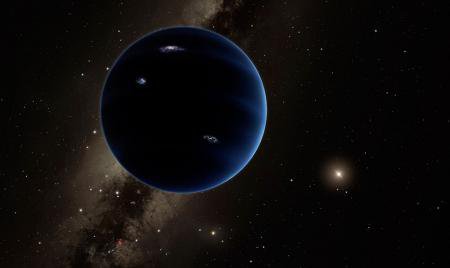
photo artistic rendering shows the distant view from Planet Nine
A New Ninth Planet? Caltech Scientists Reveal Evidence of Massive Planet in Distant Orbit
the staff of the Ridgewood blog
Ridgewood NJ, Caltech researchers have uncovered compelling evidence for a massive, unseen planet lurking in the outer regions of our solar system. Nicknamed Planet Nine, this theoretical planet could reshape our understanding of the solar system’s structure and evolution.
Based on computer simulations and orbital models—not yet direct observation—the planet is believed to be about 10 times the mass of Earth and orbiting 20 times farther from the Sun than Neptune, which itself lies about 2.8 billion miles away. Its eccentric orbit means one full revolution around the Sun could take between 10,000 and 20,000 years.
Why Planet Nine Matters
“If confirmed, this would be a real ninth planet,” said Mike Brown, Professor of Planetary Astronomy at Caltech, who is also known for his role in the demotion of Pluto. “It’s the most planet-y of all the planets in the solar system.”
Unlike Pluto and other dwarf planets, Planet Nine would gravitationally dominate its orbital zone—making it a full-fledged planet under current definitions.
Discovery Through Simulation, Not Observation (Yet)
Brown and Konstantin Batygin, an assistant professor of planetary science at Caltech, published their findings in the Astronomical Journal. They first became intrigued when noticing six icy objects in the Kuiper Belt all had similar, elongated orbits—something with a statistical chance of just 0.007% of happening randomly.
Their computer simulations showed that the best explanation for this clustering was the presence of a large planet on a highly elongated, anti-aligned orbit. This configuration would naturally shepherd these icy bodies into their current orbits—without collision, thanks to a phenomenon called mean-motion resonance.
Explaining Other Space Mysteries
Beyond explaining Kuiper Belt clustering, Planet Nine may solve other cosmic riddles:
-
It could be responsible for the strange orbit of Sedna, a distant object discovered in 2003.
-
It may explain the peculiar orbit of 2012 VP113, another remote body.
-
It also predicts a second group of objects in perpendicular orbits—a forecast now confirmed with at least five observed examples.
Batygin described the findings as “a triple win,” noting that the model not only fits the data but also makes testable predictions.
Origins: A Lost Giant from the Early Solar System?
Planet Nine might be a fifth planetary core from the early days of the solar system—ejected by gravitational interactions with Jupiter or Saturn. It would be the kind of intermediate-mass planet that is common in other star systems but, until now, was thought missing from ours.
“This discovery could make our solar system more similar to the many exoplanet systems we’re observing,” said Batygin.
What’s Next? The Hunt Is On
The exact location of Planet Nine remains a mystery, but astronomers are now combing through both archived telescope data and current sky surveys to catch a glimpse. If it’s near its closest point to the sun (perihelion), it could already be in existing imagery. If it’s farther out, astronomers will rely on powerful observatories like the Subaru Telescope or W. M. Keck Observatory in Hawaii.
Brown adds, “We’re putting this out there because we hope others will join the search. I’d love to find it, but I’d be just as happy if someone else does.”
Conclusion: A New Era in Planetary Science?
The potential discovery of Planet Nine represents more than a scientific milestone—it could rewrite the structure of our solar system and bring the planet count back to nine.
As Brown cheekily remarked, “For those still upset about Pluto’s demotion, this might be the redemption arc—except this new planet is 5,000 times more massive.”
Stay tuned as astronomers continue to scan the skies. The next planet in our solar system might be closer to discovery than we think.
Follow the Ridgewood blog has a brand-new new X account, we tweet good sh$t
https://twitter.com/TRBNJNews
https://truthsocial.com/@theridgewoodblog
https://mewe.com/jamesfoytlin.74/posts
#news #follow #media #trending #viral #newsupdate #currentaffairs #BergenCountyNews #NJBreakingNews #NJHeadlines #NJTopStories
